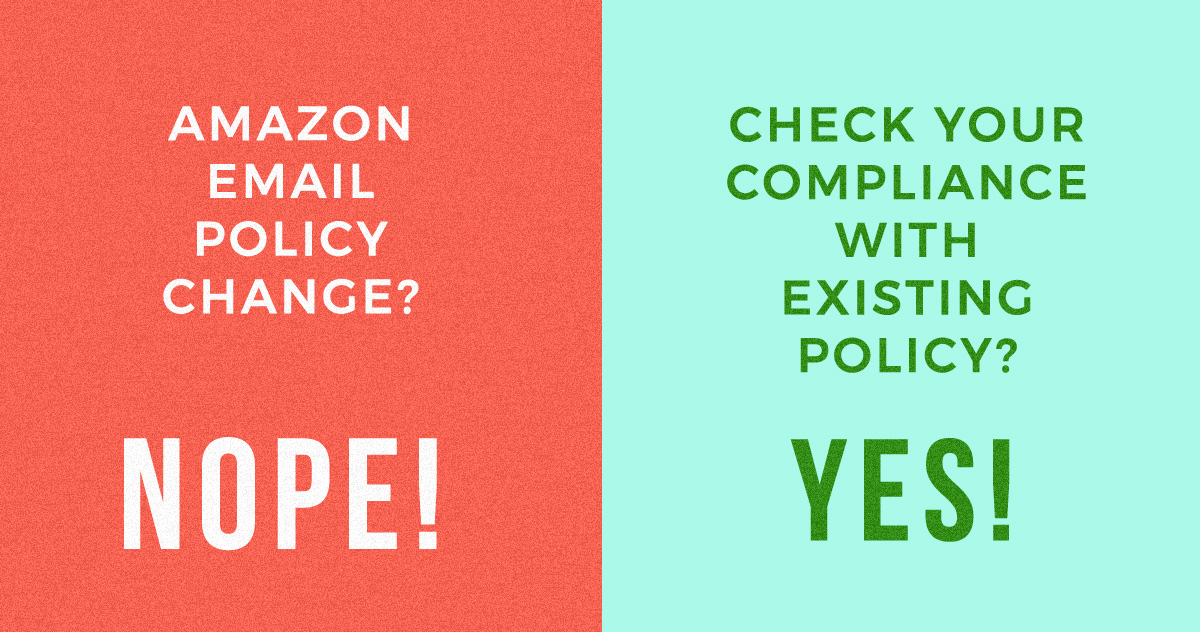Rumors have been swirling over the last several weeks about some pretty massive changes to Amazon’s email policy regarding Buyer-Seller Messaging. I want to take a moment to set the record straight about a few things and hopefully get us all back on track and focused on what really matters: Being successful sellers and upstanding members of the larger Amazon community.
Setting the Record Straight
Did Amazon make changes to the buyer-seller messaging policy? No. Period.
There were no changes made in mid-February when the rumors heated up and there have been no such changes in the meantime.
Will there be changes in the future? Of course! Change is the only constant and this is Amazon and change is how it has thrived over the decades. HOWEVER, don’t try to outguess Amazon; avoid the rumors and win by playing by the rules and by innovating and delivering; roll with the changes when they come and as they are officially released and implemented.
Sellers Behind the Wheel
You know how drivers tend to speed on long stretches of highway and slow down when they see police cars? Of course, you do, it’s really easy to forget about the speed limit when one thinks there are no consequences for “bending” the rules. But that doesn’t make it legal or safe, and at some point, there will be an officer around that next bend and he or she will ticket you.
The Amazon Marketplace is like that stretch of highway and sellers are behind the wheel. When enough sellers violate regulations, Amazon might update a policy just as a state might lower a speed limit. Other times Amazon reminds sellers of existing policies and that there are consequences for not adhering to the rules, just as a police force puts more officers on the road and greenlights those officers to write more tickets.
Right now, I am telling you that Amazon has not changed the email policy for Buyer-Seller Messaging and I am reminding you to refresh your understanding of the current policy. Let’s call it Jeff’s Drivers’ Ed for Amazon Sellers. Here’s my crash course, or rather, my course to help you not crash when it comes to Amazon Buyer-Seller Messaging.
Navigating Amazon’s Email Messaging Policy
In general, Amazon’s policy states that you cannot have “unsolicited” conversations with your buyers. A solicited conversation is when the buyer reaches out to you asking a question. An unsolicited conversation is when you reach out to the customer prior to them reaching out to you. You can communicate with buyers, you can encourage them to leave feedback and reviews, you just need to do it in keeping with Amazon rules.
Relevant Amazon Policy Documentation and Resources
Below is a list of actions that are against Amazon’s email policy. The parts I am reproducing are taken directly from Seller Central. They are all parts of lengthier pages that go into more detail. I am providing links to those pages and directly quoting sections that I believe to be the most common areas of sellers violating email policy. This is not an exhaustive list, it is a list of where I think most sellers speed and get caught.
Prohibited Seller Activities and Actions—Inappropriate email communications:
“Unsolicited emails to Amazon customers (other than as necessary for order fulfillment and related customer service) and emails related to marketing communications of any kind are prohibited.”
Improve your Feedback Rating—Best Practices:
“Problem: Happy buyers aren’t motivated to leave feedback.”
“Solution: Send the buyer a polite request for feedback after the shipment has been received.”
Prohibited Seller Activities and Actions—Misuse of ratings, feedback, or reviews:
“Ratings and Feedback: You may request feedback from a buyer.”
“Reviews: You may ask buyers to write a review in a neutral manner, but you may not ask for positive reviews, ask for reviews only from buyers who had a positive experience or ask a reviewer to change or remove their review.”
Jeff’s Tip About Reviews: Watch Your Language
In the summer of 2017, Amazon started tighter enforcement of rules surrounding “suggestive language.” This is a great example of Amazon not updating a policy but tightening up the application to ensure that sellers are following the rules. Most of this enforcement came in the form of warnings and suspensions. When experts dove into these infractions, they found that sellers were doing one of two things: only asking for positive reviews or using if/then statements. Not cool by Amazon.
Today, the best practice for sellers is to use neutral statements. The easiest way to know if you are violating this policy is to read your email. If your email states something like “If you had a good experience, please leave me a positive review,” then you are probably in violation.
As stated above, you can ask for a review, but not with conditions or incentives. That means you have to just ask your buyer to review your product, you can’t hint that you only desire positive reviews. Something like “Reviews help others get the right products. We, along with shoppers, would love to hear your thoughts” will work fine.
Attempts to Divert Transactions or Buyers
Prohibited Seller Activities and Actions—Attempts to divert transactions or buyers:
“Any attempt to circumvent the established Amazon sales process or to divert Amazon users to another website or sales process is prohibited. Specifically, any advertisements, marketing messages (special offers) or ‘calls to action’ that lead, prompt, or encourage Amazon users to leave the Amazon website are prohibited. This may include the use of email or the inclusion of hyperlinks, URLs, or web addresses within any seller generated confirmation email messages or any product/listing description fields.”
Jeff’s Tip About Diversions: You’re Not As Clever As You Think You Are
This policy within Amazon is clear, do not include a Web address or a link to any external site. While clear, the policy is still abused by sellers who feel they can get around it by using logos with links, adding a website to the signature line, or pointing to social media sites for videos. All of these actions are against policy. You may think you have found a workaround and that you are not explicitly in violation, but that is not the case and Amazon will catch up with you just as that police car will eventually catch up to that speeder.
Yes, We Can (Send Customers Emails)!
So based on all of the above, it is clear that you CAN and you MAY email customers to ask for feedback or a product review but you must do so in accordance with Amazon’s rules.
Best Practices
1. Don’t Over-Send
How many emails is too many? Well, how many emails do you get about transactions? How many do you ideally want to get? We believe that when it comes to emails, your best bet is to try to accomplish your goal with a single email. Looking at Feedback Genius users, I see that vast majority only send a single email. Talk about less being more to get the job done! As a buyer, I can tell you that any seller sending more than two emails is wasting time and annoying people. You don’t like emails, your buyers don’t like emails, and Amazon wants you to add value. If you are not enhancing the experience, you are doing it harm.
2. Obey the Opt-Out
Amazon updated their email system on March 28, 2017 to allow buyers to opt-out messages from sellers. This sent a shockwave through the seller community initially, but buyers loved it and it forced sellers to really rethink what customers want and how they want to be engaged. I think that now, we all agree that it was tough to change but it was a necessary change. That said, Seller Labs built opt-out management into Feedback Genius with the addition of the Blacklist feature. If you are not familiar with Amazon’s opt-out policy and you want to read more directly from Amazon, you can find that information here.
Wrap-Up
I hope that you got some information and advice that helps you refocus on your business and the facts at hand rather than being distracted by rumors. I also hope I’ve given you some clarification about actual Amazon email policy and that you can put that info to work so that you travel safely and smoothly without the worry of being pulled over.
What can you do today? What should you do today?
Put it all into practice. Check your customer communications and ask yourself:
- Am I following the policies?
- Am I being a good member of the seller community?
- Would I want to get this email if I were a buyer of the product?
Finally, take a deep breath, don’t believe the hype, and know that Seller Labs will always keep you updated on changes that affect your business.







